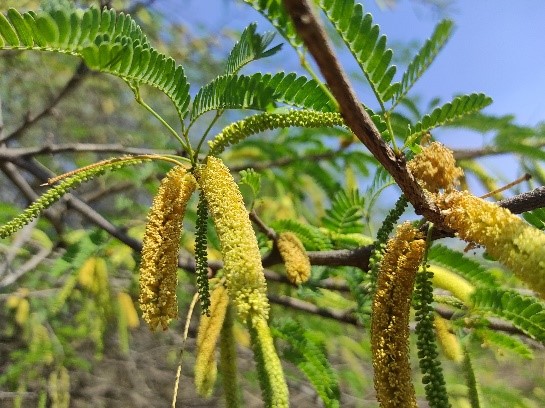Description

Disclaimer: Copyright infringement not intended.
Context
- NSG has declared a ‘war’ — on an invasive plant species -- Prosopis juliflora or Vilayati Kikar.
About
- Prosopis juliflora is a shrub or small tree in the family Fabaceae, a kind of mesquite.
Description
- Its leaves are deciduous, geminate-pinnate, light green, with 12 to 20 leaflets.
- The roots can grow over 50 meters deep, depleting groundwater, and its leaves contain toxic chemicals that prevent them from undergoing microbial degradation.
- The trees also make it difficult for native species to germinate around them.
.jpg)
Distribution
- It is native to Mexico, South America, and the Caribbean.
- It has become established as an invasive weed in Africa, Asia, Australia and elsewhere.
Menace
- It is a contributing factor to the continuing transmission of malaria, especially during dry periods when sugar sources from native plants are largely unavailable to mosquitoes.
Invasion in India
- The vilayati kikar is an invasive Mexican tree species, introduced by the British in Delhi in the 1930s.
- The tree has systemically taken over the Delhi ridge, making it difficult for other native species to grow.

Invasive Species
- An invasive species can be any kind of living organism—an amphibian (like the cane toad), plant, insect, fish, fungus, bacteria, or even an organism’s seeds or eggs—that is not native to an ecosystem.
- They can harm the environment, the economy, or even human health.
- Species that grow and reproduce quickly, and spread aggressively, with the potential to cause harm, are given the label “invasive.”
- Invasive species adversely affect habitats and bioregions, causing ecological, environmental, and/or economic damage.
- An invasive species can be introduced to a new area via the ballast water of oceangoing ships, intentional and accidental releases of aquaculture species, aquarium specimens or bait, and other means.
- Invasive species are capable of causing the extinction of native plants and animals, reducing biodiversity, competing with native organisms for limited resources, and altering habitats.
Examples: West Nile virus, chestnut blight, the South American fire ant, zebra mussels, Burmese pythons, and sea lamprey.
Some of the invasive species found in India are Alternanthera philoxeroides, Cassia uniflora, Chromolaena odorata, Eichhornia crassipes, Lantana camara, Parthenium hysterophorus, Prosopis juliflora and others.
|
PRACTICE QUESTION
Q. Recently, Prosopis juliflora was in the news. What is it?
1. Umbrella Species
2. A Flagship Species
3. An Invasive species
4. Keystone Species
Choose the correct code.
1. A
2. B
3. C
4. D
Answer
Option 3. C. An Invasive species
|














